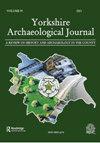Hayton, East Yorkshire: Archaeological Studies of the Iron Age and Roman Landscapes
IF 0.2
0 ARCHAEOLOGY
引用次数: 5
Abstract
purposes in a timber frame. I was a bit surprised, firstly, that the nails were not X-rayed, which experience tells me would have shown that some, at least, were not nails, and, secondly, that they were not, apparently, measured. A study of nail sizes might well have prompted thoughts about their use – or not – in the structure. One of the chalk blocks is illustrated (Illus 5.13) showing the stone tooling marks. MM suggests (148) that they had enhanced the appearance of the building (‘significant in the sunlight’), but I would have thought, again in light of chalk’s frailties, that they might well have been a key for external rendering which has not survived. In former times the Thwing building might have been classified as belonging to a ‘villa’, but a careful and considered analysis here provides one of the clearest illustrations I know of to show that we must take a more nuanced view of how people in rural areas engaged with Roman culture. The pottery, artefactual and faunal assemblages from Thwing would all be consistent with a native farmstead. Architectural pretension, on the one hand, does not necessarily, therefore, correlate directly either with new-found prosperity supposedly derived from changes in estate management (270) or with an ambition to acquire the material culture associated with a traditional Romanised life style. I could say much more about the subjects covered in this well-written volume, illustrated in an exemplary manner, but I will conclude by saying that for anyone interested in the landscape history of the Wolds, the interaction of native and Roman, and many other topics relevant to the study of Roman Britain there is much of interest here. Just one serious quibble: fair (in the sense of a market) is spelled ‘fair’ and not (270) ‘fayre’ (ugh!).东约克郡海顿:铁器时代和罗马景观的考古研究
木构架的用途。我有点惊讶,首先,这些钉子没有经过x光检查,经验告诉我,至少有一些不是钉子,其次,它们显然没有经过测量。一项关于钉子大小的研究可能会促使人们思考它们在建筑中是否使用。其中一个粉笔块(见图5.13)显示了石制工具的痕迹。MM建议(148),它们增强了建筑的外观(“在阳光下显着”),但我认为,再一次考虑到粉笔的脆弱性,它们很可能是外部渲染的关键,但没有幸存下来。在以前,Thwing建筑可能被归类为属于“别墅”,但这里的仔细和深思熟虑的分析提供了我所知道的最清晰的例证之一,表明我们必须对农村地区的人们如何与罗马文化接触采取更细致入微的看法。从Thwing发现的陶器、人工制品和动物组合都与当地的农场相一致。因此,一方面,建筑上的自命不凡并不一定与房地产管理变化所带来的新繁荣直接相关(270),也不一定与获得与传统罗马生活方式相关的物质文化的野心直接相关。关于这本写得很好的书所涵盖的主题,我可以说得更多,以一种典范的方式进行说明,但我最后要说的是,对于任何对世界景观史、土著和罗马人的相互作用以及与罗马不列颠研究相关的许多其他主题感兴趣的人来说,这里有很多有趣的东西。只有一个严重的问题:fair(在市场的意义上)拼写为fair,而不是fayre(啊!)。
本文章由计算机程序翻译,如有差异,请以英文原文为准。
求助全文
约1分钟内获得全文
求助全文

 求助内容:
求助内容: 应助结果提醒方式:
应助结果提醒方式:


